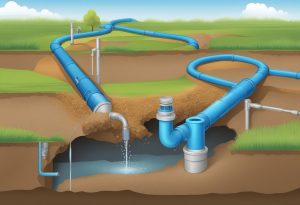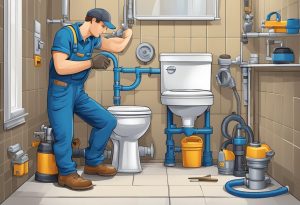Moisture issues in the home are not just a nuisance but can be a serious threat to the integrity of the building and the health of its occupants. Excess moisture can lead to the growth of mold and mildew, contribute to structural damage, and attract pests. Homeowners can take proactive steps to manage the humidity levels and prevent moisture problems before they start. Understanding the dynamics of moisture in various environments within a home is crucial. This includes recognizing the common areas where moisture can enter and accumulate, such as the attic, basement, and crawl spaces.

Moisture control is a combination of building science and preventative measures. It involves the correct use of materials and construction techniques designed to shield the interior of a home from water intrusion and condensation. Routine inspections and maintenance are essential for early detection of potential problems, allowing for timely repairs and interventions. By following these practices, homeowners ensure the longevity of their property and create a healthier living environment.
Key Takeaways
- Moisture in the home can cause structural damage and health issues.
- Effective control requires an understanding of home moisture dynamics.
- Regular maintenance is essential for preventing moisture-related problems.
Understanding Moisture Dynamics in Homes
To effectively prevent moisture issues in homes, homeowners must recognize the intricate interplay between various factors like air movement, diverse moisture sources, and the relationship of temperature to humidity and dew point.
The Role of Ventilation and Air Movement
Proper ventilation is integral to managing moisture in a home. It ensures that there is a continuous exchange of indoor air with outdoor air, which helps to dilute and remove moisture. For example, the use of exhaust fans in bathrooms and kitchens can expel moist air directly outside, preventing the accumulation of humidity.
Moisture Sources and Effects on Indoor Air Quality
Indoor activities and structural issues can introduce excessive moisture into the air. Sources include activities like cooking and showering, as well as structural problems such as leaks from roofs or pipes. High indoor humidity levels can lead to mold growth and reduced indoor air quality, making it necessary to identify and mitigate these sources promptly.
Temperature, Humidity, and Dew Point Relation
The concepts of temperature, relative humidity, and dew point are crucial in understanding moisture behavior inside a home. The dew point is the temperature at which air becomes fully saturated with moisture and condensation begins. Maintaining an indoor temperature higher than the dew point prevents condensation on surfaces. Keeping relative humidity levels below 60% typically wards off moisture-related issues.
By grasping these aspects of moisture dynamics, homeowners can create a more comfortable and structurally sound living environment.
Critical Areas of Moisture Ingress and Accumulation

Identifying and addressing areas prone to moisture ingress and accumulation is essential in preserving the structural integrity and indoor air quality of a home. Homeowners should pay close attention to walls, attics, foundations, and other critical points where moisture may enter or accumulate.
Walls, Windows, and Roof Concerns
Walls and windows are common entry points for moisture. Leaks can occur through cracks or faulty seals around windows, which, if not addressed, could lead to structural damage and mold growth. The roof, being the uppermost barrier of a home, is subject to weather extremes and requires regular inspections to ensure the drainage system, such as gutters and downspouts, is functioning properly to redirect water away from the home.
- Walls: Check for cracks and signs of moisture penetration; ensure proper exterior cladding.
- Windows: Seal gaps and ensure weather-stripping is intact.
- Roof: Inspect for damaged shingles or tiles; clear gutters regularly.
Foundation and Basement Moisture Challenges
The foundation and basement are at high risk for moisture problems due to their proximity to the ground. They can suffer from both internal and external sources of moisture. Proper insulation and a robust drainage system are critical to managing moisture. Homeowners should ensure there are no cracks in the foundation walls and that the basement is well-sealed.
- Foundation: Install a proper drainage system; apply waterproof coatings.
- Basement: Inspect for leaks; maintain sump pumps and dehumidifiers.
Attics and Insulation Implications
Attics must be properly insulated and ventilated to prevent moisture from accumulating and causing mold or rot. Insulation should be dry and intact, and attic vents should be clear to allow for adequate airflow. Unchecked moisture in attics can compromise the effectiveness of insulation and lead to increased energy costs.
- Attics: Ensure effective ventilation; inspect insulation periodically.
- Insulation: Replace if wet or damaged; consider moisture-resistant products.
Effective moisture management in these areas can lead to a healthier living environment and avoid costly repairs.
Effective Moisture Control Measures
Effective moisture control measures are critical to sustaining a healthy and durable indoor environment. They involve a combination of strategies that prevent water ingress, manage indoor humidity levels, and ensure that homes have proper seals against moisture penetration.
Essentials of Drainage and Waterproofing
Proper drainage systems are the first line of defense against moisture problems. They divert water away from the home’s foundation to prevent structural damage and reduce the likelihood of indoor dampness. This includes the installation of gutters and downspouts that are regularly cleaned and maintained. Additionally, waterproofing barriers should be applied to the exterior walls of the basement or crawlspace to block the ingress of groundwater.
The Importance of Vapor Barriers and Sealants
Vapor barriers are critical in preventing moisture from diffusing into the home. These barriers, typically made of plastic or foil, are installed on the warm side of walls and attic spaces to impede the passage of water vapor. When paired with effective caulking around windows, doors, and other penetration points, vapor barriers contribute to a comprehensive moisture control strategy.
Strategies for Controlling Indoor Humidity
Maintaining optimal humidity levels within the home is essential to prevent condensation and mold growth. The use of dehumidifiers in basements and other prone areas actively reduces moisture in the air. It is also advisable to use exhaust fans in kitchens and bathrooms to vent out humid air. Regular monitoring of indoor humidity is important, and levels should ideally stay between 30% and 50%.
Building and Material Science for Moisture Management
In the complex interplay of building science and material engineering, the effective management of moisture is fundamental to the longevity and health of a home. Selecting the right construction materials and techniques, along with leveraging innovations in moisture-resistant products, supports the integrity of the building envelope and ensures adequate ventilation.
Construction Materials and Techniques
When constructing a building, choosing materials that suit the specific climate and environmental conditions is critical. The construction style should be designed to prevent moisture accumulation, incorporating flashing at seams and ledges to direct water away from the structure. Proper installation of materials is just as important as the materials themselves to prevent moisture intrusion. For example, materials like brick and stone can be excellent for certain climates, while in others, siding materials designed to “breathe” may be more appropriate.
To bolster these efforts, building science promotes the use of techniques that maintain an equilibrium of moisture and airflow within a structure. This involves creating a continuous air barrier combined with adequate ventilation to allow excess moisture to escape from the building interior. Homes should be designed so that the moisture that does penetrate the building envelope can also escape or be channeled such that it does not cause damage.
Innovations in Moisture-Resistant Products
Progress in building materials includes the development of products specifically designed to resist moisture and manage its effects on a building structure. Innovations such as vapor-permeable, yet water-resistant barriers, have transformed the way buildings are protected. Moisture-resistant materials like treated wood, moisture-managed drywall, and non-organic insulation are increasingly used in areas prone to dampness.
The deployment of smart barriers that adapt to humidity levels ensures that these materials only allow moisture to escape, not enter, complementing the building’s ventilation system. Moreover, advanced sealants and membranes are used to protect vulnerable points in the building envelope from water ingress, while still allowing the structure to breathe and regulate the internal moisture levels.
Preventative Maintenance and Routine Inspections
Preventative maintenance and routine inspections are critical strategies in proactive home care. These methods aim to mitigate issues by identifying and curbing moisture-related problems, like mold growth and material deterioration, before they escalate.
Identifying and Addressing Moisture Issues Early
Detecting excessive moisture early can prevent a variety of problems in a home. Homeowners should schedule regular inspections that focus on areas prone to moisture buildup such as bathrooms, kitchens, and basements. During these inspections, particular attention should be paid to:
- Plumbing fixtures and pipes for any signs of leaks
- Windows and doors for proper sealing and weather-stripping
- Ventilation systems, ensuring they are free of obstructions and functioning properly
If moisture is detected, it’s essential to address it immediately to prevent mold growth and structural damage.
Regular Upkeep to Prevent Mold and Deterioration
Consistent maintenance is essential to prevent the conditions that allow mold to thrive and building materials to deteriorate. Homeowners can take several preventative steps:
- Ventilation: Ensure that all areas, especially those that are moisture-rich, are well-ventilated.
- Gutters and Downspouts: Keep them clean and unclogged to prevent water from pooling around the foundation.
- Roof and Flashing: Inspect them biannually to ensure that there is no water intrusion.
By establishing a maintenance routine, homeowners protect their property from the damaging effects of moisture and extend the lifespan of their home’s components.
Frequently Asked Questions
In this section, homeowners will find targeted solutions to common moisture issues, including strategies to reduce indoor humidity and practical steps for moisture control in various home scenarios.
What are effective methods for reducing indoor humidity during the rainy season?
To reduce indoor humidity during the rainy season, homeowners should ensure proper ventilation by using exhaust fans and periodically opening windows when possible. Additionally, running a dehumidifier can effectively lower moisture levels inside the house.
Which outdoor humidity control strategies are beneficial for homeowners?
Homeowners can benefit from improving drainage around the house to keep moisture away from the foundation. It’s also essential to fix any leaks in roof flashing, walls, or windows to prevent water from seeping into the home.
What are the best practices for moisture control in stored food?
For controlling moisture in stored food, it is crucial to use airtight containers and to store goods in cool, dry places. Desiccants like silica gel packets can also be used to absorb excess moisture and keep food dry.
How can a homeowner quickly lower the humidity level inside their home?
To quickly lower humidity, homeowners should utilize dehumidifiers, activate air conditioning units, and ensure that clothes dryers and stove vents are properly vented to the outside to prevent moist air from recirculating indoors.
What steps can be taken to eliminate moisture accumulation beneath a house?
To eliminate moisture under a house, homeowners should consider installing a vapor barrier over the soil in crawl spaces and improving the site grading to direct water away from the home’s foundation. Ensuring proper ventilation in these areas is also critical in keeping them dry.
Which houseplants are known to assist in reducing indoor humidity levels?
Certain houseplants, such as Peace Lilies and English Ivies, can assist in reducing indoor humidity levels through a process called transpiration. However, it’s important not to overwater plants as this can contribute to higher humidity.
Water Leak Underground: Causes, Signs, and Solutions
Water leaks underground can be a significant concern for homeowners, as they are often challenging to detect and can lead to costly damage if left
Seven Engineering and Professional Services: Advancing Global Expertise in Innovative and Inclusive Technology
In the rapidly evolving landscape of engineering and professional services, we see an undeniable trend towards leveraging advanced technology to empower experts around the globe.
Water Leakages Detected Malaysia: Nationwide Solutions and Prevention Strategies
Underground Water Leak Detection: Vital Approaches for Early Identification Key Insights Underground water leak detection is crucial for preventing water wastage and damage to infrastructure.

How are underground water leaks detected?
Underground Water Leak Detection: Essential Strategies for Early Discovery Underground water leaks are a pervasive issue that can lead to significant water wastage and financial

Toilet Repair: Essential Tips for Fixing Common Issues
Toilet repair is an essential aspect of home maintenance, as a properly functioning toilet is crucial for the comfort and hygiene of any household. Common

Plumbing Inspections Kuala Lumpur: Your Guide to Expert Services
When considering the purchase of a property in Kuala Lumpur, securing a plumbing inspection is a smart move that goes beyond just checking off a box. It’s
SEVEN ENGINEERING (BERLIN) GLOBAL TECH BHD
SEVEN ENGINEERING (BERLIN) INNOVATION DESIGN & SERVICES SDN BHD



